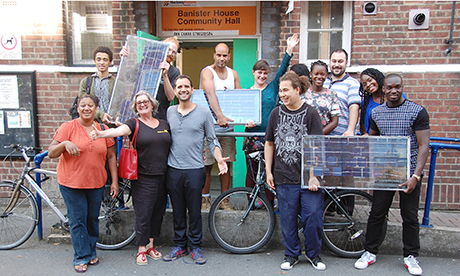Hackney Energy offers shares to fund solar start-up

A good source of energy: Solar enthusiasts outside Banister House community hall. Photograph: Hackney Energy
Small-scale investment through energy co-operatives is on the rise, with several groups around the country promising low-risk, ethical investment, and higher returns than an ISA.
Now Hackney Energy, in partnership with Repowering London, is calling on Hackney residents to funnel their cash into Hackney’s first community-owned solar array, a set of solar panels, predicting 4 per cent returns and promising significant tax breaks – if you’re willing to lock your money away for 20 years.
Through a new share offer launching tonight (31 March), Hackney Energy is looking to raise £142,000 in eight weeks to fund the installation, offering shares ranging from £50 up to £40,000.
If the share offer is successful, the panels will be in place by June, and will generate up to 82,000 kilowatt hours of energy (kWh) per year from the roofs of 14 buildings on the Banister House estate in Homerton.
Hackney energy firm Athena Electrical has been commissioned to install the panels with the help of 10 young people on paid work experience, all recruited from Banister House, one of the borough’s largest housing estates.
How does it work?
Energy generated on the roofs of Banister House will contribute electricity to the grid that the estate’s electricity supplier will, by law, have to pay for.
Anyone who installs solar electric arrays up to 5 megawatts is paid for their contribution to the grid through the government’s 2010 Feed In Tariff (FIT) scheme.
Through the FIT, small-scale generators of renewable energy like the Banister House co-op earn an inflation-protected £0.1282p per kWh for any electricity generated for their own use (the ‘Generation Tariff’), and £0.0485 per kWh for electricity the scheme contributes to the grid overall (the ‘Export Tariff’).
If the Banister House scheme can’t raise enough money, the array will not be installed. But uncertainties aside, Hackney Energy has already secured a key client in Hackney Homes, who have agreed to purchase energy from the co-op to power the communal areas of the estate, at a 20 per cent discount.
The appeal of a community-based renewable energy investment may draw a crowd, but for investors deciding whether to funnel their money into the co-op, it “depends on their attitude to risk,” says Hackney Energy’s James Diamond, who helped draw up the co-op’s financial plan.
What are the benefits?
– Your investment is returned after 20 years. Shares may be withdrawn after three years subject to approval of the directors.
– Investors get a 50 per cent tax break on their investment through the Seed Enterprise Investment Scheme (SEIS). After three years of investment, £125 of a £250 share can be claimed against your annual tax bill.
– Lower energy bills for the council, who will receive a 20 per cent discount on energy purchased from the Banister House project.
– The share offer predicts higher returns than a savings account or an ISA, which generally offer returns closer to 1-2 per cent. The co-op predicts a 4 per cent return.
What are the risks?
– Your cash is put away for 20 years. You need to keep it invested for at least three years to qualify for the tax break.
– A volatile energy market. The estimated interest rate of 4 per cent is subject to profits. In the event that energy costs plummet (unlikely, as they have risen by 10–20 per cent per year since 2003), or the solar array doesn’t produce as much energy as expected due to shade or technical issues, profits will fall.
– If the array is permanently damaged or the scheme goes bust, investments would be lost. The Banister House scheme is only protected against temporary damage.
How will it be run?
Anyone who pledges money through the share offer, no matter how much, will become a member of the community benefit company, or ‘Ben-com’ with a one-member-one-vote system, and five member-elected directors who will run the co-op’s finances.
After paying running costs the Ben-com will make a net profit. The Ben-com will decide how to split the profits, with an eye to reinvesting 20 per cent of profits into a community fund, and the rest paying a dividend to shareholders.
The Hackney Energy share offer will run from 31 March to 26 May 2015
